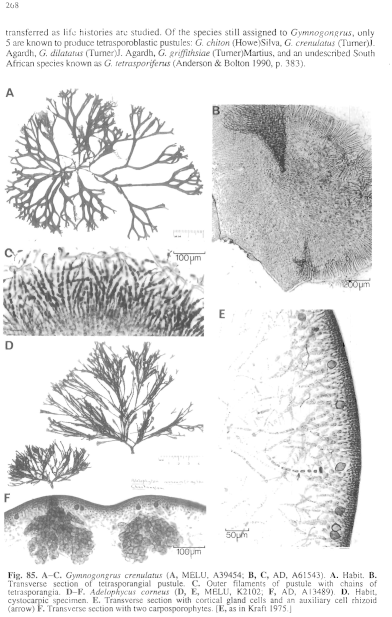|
|
|
|
|
|||||||||||
|
Electronic Flora of South Australia Species Fact Sheet
Phylum Rhodophyta – Class Florideophyceae – Order Gigartinales – Family Phyllophoraceae
Selected citations: Dixon & Irvine 1977b: 217, fig. 78. Maggs 1990: 121.
Synonym
Fucus crenulatus Turner 1802: 130, pl. 8 figs 3,4.
Thallus (Fig. 85A) medium to dark red-brown, 3–8 cm high, cartilaginous, subdichotomous at intervals of 0.5–3 cm, more or less complanately branched, branches flat, 2–4 mm broad, margins straight to slightly crenulate, slightly narrower basally, axils broad, apices rounded, often with small proliferous leaflets from lower parts; holdfast small, discoid, with one to a few fronds; epilithic. Structure multiaxial with ovoid cells throughout, cortical cells in anticlinal chains of 3–4 cells when young, becoming 7–10 cells long in older parts, 3–6 µm in diameter, cells L/D 1–2 (–3), developing secondary lateral pit-connections. Medulla 3–6 cells thick, cells 100–250 µm in diameter, L/D 2–3, with thick walls (15–25 µm), more or less in tiers in longitudinal section, with numerous secondary pit-connections. Rhodoplasts discoid to elongate, few per cell.
Reproduction: Sexual reproduction unknown in Australian plants.
Tetrasporangial pustules (Fig. 85B) usually on lower branches, 1–3 mm across and 1–2 mm high, also with long filaments extending from adjacent cortical cells, simple to slightly branched, filaments 6–9 µm in diameter with cells L/D 1.5–2.5 below, with numerous lateral secondary pit-connections, tapering to 2.5–4 µm in diameter with cells L/D 3–5 above and developing chains (with 1–2 terminal sterile cells) (Fig. 85C) of 5–10 ovoid tetrasporangia 8–11 µm in diameter, cruciately divided.
Type from Oporto, Portugal; lectotype in BM.
Selected specimens: Topgallant I., S. Aust., 10 m deep (0' Leary, 20.i.1992; AD, A61673). Henley Beach, Adelaide, S. Aust., drift (C. & G. Kraft, 6.iii.1971; MELU, A39475). Port Noarlunga, S. Aust., lowest eulittoral, shaded, just N of jetty (Ricci & Womersley, 8.ii.1993; AD, A61799). Robe, S. Aust., pool near jetty (Womersley, 7.xii.1991; AD, A61543). Portarlington, Vic., sublittoral (King, 16.x.1969; MELD, 4733). Werribee, Vic. (Brown, 20.i.1982; MELU, A39455). Altona, Vic., 2 m deep (Brown, 6.ix.1983; MELU, A39454). Williamstown, Vic., 2 m deep (Brown, 13.viii.1974; MELU, A21815; AD, A46028). St Kilda, Vic., 3 m deep (by diver, 23.ii.1976; MELU, A22272). Botanic Gardens, Sydney (Port Jackson), N.S.W., low intertidal (Kraft, 21.xi.1983; MELU, A39469).
Distribution: British Isles, eastern Europe, Mediterranean, eastern N. America.
In southern Australia, from Topgallant I., S. Aust., to Port Phillip, Vic., and Port Jackson, N.S.W.
Taxonomic notes: Further studies are needed on the reproduction and life history of G. crenulatus. Dixon & Irvine (1977b, p. 218) refer to sexual reproduction preceding the pustules of tetrasporangia, but this has yet to be confirmed in Australian material; also many of the pustule filaments appear to arise directly from outer cortical cells. Dixon & Irvine also refer to "occasionally produced immersed cystocarps ... containing normal carposporangia", but these cystocarpic plants are now known to be a separate species, Ahnfeltiopsis devoniensis (Greville) Silva & DeCew (1992, p. 577).
Australian specimens agree well with British material and may be adventives, since most collections are from near harbours.
References:
AGARDH, J.G. (1851). Species Genera et Ordines Algarum. Vol. 2, Part 1, 1–336 + index. (Gleerup: Lund.)
DIXON, P.S. & IRVINE, L.M. (1977b). Seaweeds of the British Isles. Vol. 1, Rhodophyta. Part I, Introduction, Nemaliales, Gigartinales. [British Museum (N.H.): London.]
MAGGS, C.A. (1990). Taxonomy of phyllophoroid algae: the implications of life history. Hydrobiologia 204/205, 119–124.
SILVA, P.C. & DECEW, T.C. (1992). Ahnfeltiopsis, a new genus in the Phyllophoraceae (Gigartinales, Rhodophyceae). Phycologia 31, 576–580.
TURNER, D. (1802). Descriptions of four new species of Fucus. Trans. Linn. Soc. 6, 125–136.
The Marine Benthic Flora of Southern Australia Part IIIA complete list of references.
Publication:
Womersley, H.B.S. (14 January, 1994)
The Marine Benthic Flora of Southern Australia
Rhodophyta. Part IIIA, Bangiophyceae and Florideophyceae (to Gigartinales)
Reproduced with permission from The Marine Benthic Flora of Southern Australia Part IIIA 1994, by H.B.S. Womersley. Australian Biological Resources Study, Canberra. Copyright Commonwealth of Australia.
Illustration in Womersley Part IIIA, 1994: FIG. 85 A–C.

Figure 85 enlarge
Fig. 85. A–C. Gymnogongrus crenulatus (A, MELU, A39454; B, C, AD, A61543). A. Habit. B. Transverse section of tetrasporangial pustule. C. Outer filaments of pustule with chains of tetrasporangia. D–F. Adelophycus corneus (D, E, MELU, K2102; F, AD, A13489). D. Habit, cystocarpic specimen. E. Transverse section with cortical gland cells and an auxiliary cell rhizoid (arrow) F. Transverse section with two carposporophytes. [E, as in Kraft 1975.]

|
Email Contact: State Herbarium of South Australia |

|